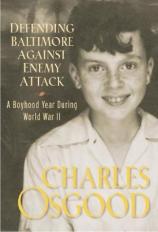Defending Baltimore Against Enemy Attack: A Boyhood Year During World War II
Review
Defending Baltimore Against Enemy Attack: A Boyhood Year During World War II
Charles Osgood, a well-known radio and television personality ("The
Osgood File" on CBS), has written a book tailored to the TV
age.
It is short (only 139 pages, 13 of which are devoted to pictures or
are otherwise blank). Its chapters, obviously enough, are short
too. There's a good deal of homey dialogue. The whole thing can be
easily read in one sitting. The feeling is relentlessly warm and
fuzzy. World War II, or more exactly the year 1942, experienced
through Osgood's nine-year-old senses, is merely offstage noises.
What matters most is his own kid-oriented life on the home
front.
Full disclosure: Charles Osgood is two and a half years younger
than myself. Many of the things he remembers from wartime Baltimore
were also true in my own wartime Boston. Virtually anyone in that
age bracket could have written a similar remembrance. Osgood,
however, has the good luck to bear a media "name" that will attract
readers. I do not begrudge him that good luck, but in essence his
book is a tasty cream puff, quickly digested and soon more or less
forgotten, rather than a meaty literary meal.
There are other threads beyond the war in Osgood's remembrance of
things past. He waxes lyrical over old-time radio, over his
infatuation with baseball as played by the then minor league
Baltimore Orioles, and over his crush on the enchanting Sue
Einstein. His book is also filled with invidious comparisons of
American life today as opposed to the idyllic days of 1942 when
rules were rules and their infraction brought stern punishment,
when kids really learned stuff in school, and when leisure time was
for simple, unprogrammed dreaming. He even gets in a gentle whack
or two at the dominance of television in the lives of kids today;
one hopes this will not jeopardize his TV paychecks.
Osgood's paean to old-time radio is laced with the lyrics of
long-gone commercial jingles ("We feed our doggie Thrive-O, he's
very much alive-o"), memories of radio serials and quiz shows, and
popular songs. He even mentions favorably the radio writer Norman
Corwin, who was a resident of my hometown near Boston. Osgood is
correct, of course, to salute radio's unique ability to stimulate
the young imagination in the absence of television's visual images.
Good point --- but one that had been made many times before, and
often more eloquently.
The pictures of nine-year old Charles and his family are delightful
--- the one on the dust jacket is especially cherishable --- but
some of the others are mere generic images that have no obvious
relevance to Osgood himself: a school classroom, a German warplane,
a woman in a Victory Garden, an old radio. Babe Ruth, whose playing
career ended seven years before Osgood's birth, and Lou Gehrig, who
died in 1941, are both invoked as patron saints of the boy's
baseball worship.
DEFENDING BALTIMORE AGAINST ENEMY ATTACK is a fun book to while
away an hour or two, a book with no pretension to profundity or
true literary distinction. Osgood fans will doubtless enjoy it,
however.
Reviewed by Robert Finn (Robertfinn@aol.com) on December 29, 2010
Defending Baltimore Against Enemy Attack: A Boyhood Year During World War II
- Publication Date: May 12, 2004
- Genres: Nonfiction
- Hardcover: 139 pages
- Publisher: Hyperion
- ISBN-10: 1401300235
- ISBN-13: 9781401300234



